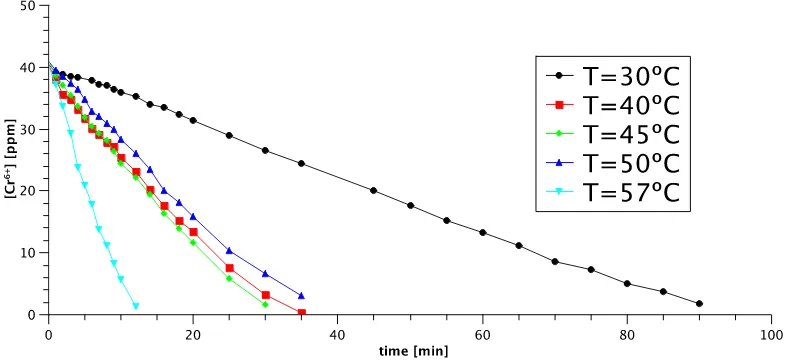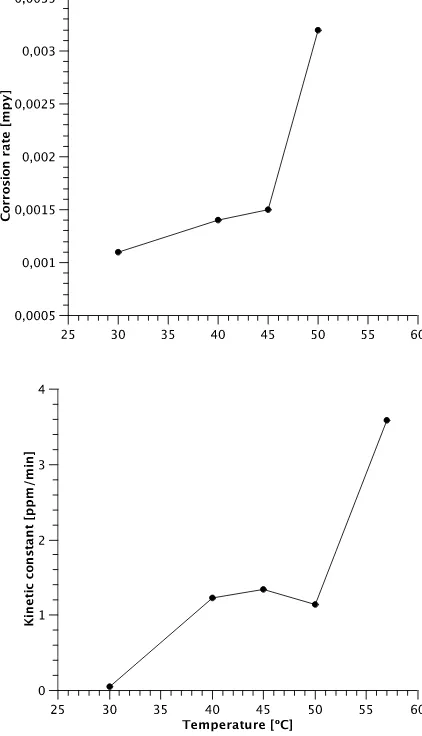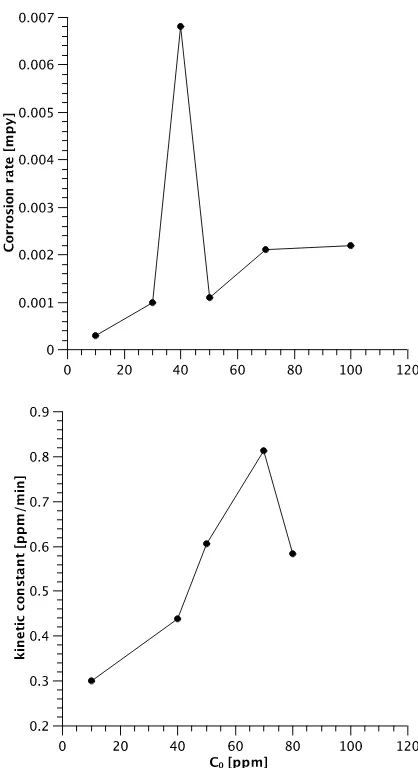Int. J. Electrochem. Sci., 9 (2014) 2556 - 2564
International Journal of
ELECTROCHEMICAL
SCIENCE
www.electrochemsci.org
Chromium (VI) Reduction Kinetics by Zero-valent Aluminum
Patricia Treviño, Jorge G. Ibanez*
, Ruben Vasquez-Medrano
Depto. de Ingenieria y Ciencias Quimicas. Universidad Iberoamericana. Prol. Reforma 880, 01219 Mexico, DF. Mexico.
*
E-mail: jorge.ibanez@ibero.mx
Received: 21 January 2013 / Accepted: 31 January 2014 / Published: 2 March 2014
Chromate reduction by zero-valent aluminum was studied by UV-Vis spectroscopy and rotating disc voltammetry to better understand its mechanism and evaluate kinetic parameters. Reduction of Cr(VI) with aluminum responds to a zeroth order kinetic model. Experiments revealed that the first step is the dissolution of the protective oxide film of Al. Data confirmed the importance of the surface area available for reaction. Polarization curves showed that corrosion rate increases with reaction temperature and with the initial chromate concentration.
Keywords: aluminum, chromate, kinetics, redox reaction.
1. INTRODUCTION
The most important oxidation states of Cr are +3 and +6. Chromium toxicity depends on its oxidation state: while trivalent chromium is an essential nutrient for plant and animal metabolism in trace amounts [1], hexavalent compounds are known to be toxic, corrosive and carcinogenic causing various health problems [2,3]. Cr(VI) does not exhibit insoluble species in spite of pH variations and thus its ions are extremely mobile in water and soil. On the other hand, the trivalent state forms insoluble species in a wide pH range. Therefore, to form a chromium solid phase it is often necessary to modify the oxidation state [2].
In its trivalent state, chromium forms strong complexes with hydroxides. The dominant hydroxo species are CrOH2+ at pH values from 3.8 to 6.3, Cr(OH)3 at pH values from 6.3 to 11.5, and Cr(OH)4- at pH values >11.5 [4]. Because the redox potential of the Cr(VI)/Cr(III) couple is rather high, there are few oxidants present in natural systems capable of oxidizing Cr(III) to Cr(VI) [4].
Chromium (VI) is used in a variety of applications including electrodeposits, steel production, metal finishing, dye production, and water cooling [5]. U.S. regulations have set the following limits for chromium discharges: 170 mg/L of Cr(III) and 0.05 mg/L of Cr(VI). The U.S. EPA Drinking Water regulation limits total chromium to less than or equal to 0.1 mg/L [5]. The solubility of Cr(OH)3 keeps chromium concentrations below the drinking water limit at pH 6-12 [4].
Treatment strategies for undesirable chromium species include traditional chemical reduction, electrochemical methods (including electrocoagulation and electrodissolution), photocatalytic reduction, and biological reduction [5-8]. In general, the chemical and electrochemical methods require that the process take place under acidic conditions so that the chromium ions remain in the aqueous phase where the reactions take place. When the pH of the solution is raised, chromium hydroxides precipitate. On the other hand, biological methods require fewer reagents (mainly carbon sources) and are therefore simpler; although some aquatic bacteria and fungi are relatively tolerant to high levels of Cr(VI), it is a strong oxidant and at a certain level it attacks microbes at their membranes and tissues [2].
Zero-valent metals can serve as electron donors for the reduction of oxidized species under certain conditions. The thermodynamic instability of the metal can drive oxidation-reduction reactions without external energy input, if suitable coupled reactions can occur to prevent accumulation of electric charge. CrO42- can serve as the oxidant in this reaction scheme and become reduced [9-14]. This paper presents a study of the reduction reaction of Cr(VI) with zero-valent Al [13].
2. EXPERIMENTAL DETAILS
Chemicals
Potassium dichromate (Merck, ACS grade) and sulfuric acid (Merck, 96%) were used as received. The Al foam was Duocel (10 and 40 ppi, pores per square inch, density = 0.3491 and 0.2034 g/cm3, respectively, from Energy Research and Generation, Oakland, CA). Al shots were from Aldrich (>99.999%). Distilled water was used for the preparation of solutions.
For the kinetic studies the reductions of Cr(VI) solutions at pH 2 were carried out with 0.30 g of Al at different temperatures ranging from 25 to 60 ºC. The advance of the reaction was followed by absorbance measurements in a UV-VIS Cary 300 Varian spectrophotometer. For the preliminary tests, the Al foam was used as received; for the subsequent reactions the Al foam was pretreated in a sulfuric acid bath (see below). The effect of the surface area was studied by comparing results with Al shots and Duocel Al foam of 10 and 40 ppi.
3. RESULTS AND DISCUSSION.
a. Pretreatment effect.
[image:3.596.82.517.202.391.2]Figure 1 contains the spectra obtained when a 40 ppm solution of Cr(VI) was reduced by Al foam of 40 ppi at different temperatures.
Figure 1. Kinetic results at different temperatures with untreated Al.
Figure 2. Concentration profiles for Cr(VI) when exposed to an Al foam pretreated in a 1 N sulfuric acid bath. Results obtained with Al pretreated for 10-min in a 0.1 N sulfuric acid bath are also shown for comparison.
[image:3.596.83.522.438.636.2]
rate is kinetically controlled, but at higher temperatures (i.e., when the rate has been sufficiently accelerated), mass transfer becomes more important and governs the reaction rate.
The reaction rate increases after the first 10 minutes. This is attributed to the removal of the natural oxide film. In order to further explore this hypothesis, Al foam was pretreated in an acid wash. Similar reactions using a pretreatment step have yielded quite different results. For instance, in the Cr(VI) reduction with copper, experiments using an acid wash yielded irreproducible results presumably because of varying degrees of oxide film removal [1], while both iron coated with a water-formed oxide, and oxide-free iron were effective for chromate removal [9-11]. In order to completely remove its natural oxide film, Al foam was pretreated in a 0.1 N sulfuric acid wash for 1 - 10 min. No significant changes in the reaction kinetics were observed. These results were then compared with a pretreatment in 1.0 N sulfuric acid (Figure 2). While a 0.1 N sulfuric acid wash has no effect in the reduction rate, all the reactions with 1.0 N sulfuric acid wash displayed faster and more uniform reduction rates. Because of this, pretreatments with 1.0 N sulfuric acid wash for 30 min were applied for further reduction studies.
b. Temperature effect.
Reductions of Cr(VI) with pretreated Al foam were performed at different temperatures from 30 to 60 ºC (Figure 3).
Figure 3. Chromate concentration profile at different reaction temperatures using pretreated Al foam.
[image:4.596.102.495.429.609.2][image:5.596.100.504.156.344.2]
the deviation observed in the cyclic voltammetric studies (see below). Without this value, the linear correlation R2 is 0.979 which represents a reasonable fit. Values obtained from this linear regression are: activation energy, Ea = 62.2 kJ/mol and a pre-exponential factor, A = 2.47 x 1010 ppm/min.
Figure 4. Arrhenius fit for the reaction rate dependence on temperature.
c. Reaction order.
Rates of Cr(VI) removal from solution by Al can in principle by described by models of the form:
(2)
where k is the rate constant that depends on the Al type and surface area, solution chemistry, and pH. The parameter n is the reaction order with respect to the aqueous Cr(VI) concentration [Cr(VI)] [9,10]. According to Figure 3, the reduction of Cr(VI) with Al is described by a zeroth-order model. This agrees well with the reaction rate order reported for Cr(VI) reduction by iron [9,10].
Table 1. Kinetic constants for reactions with pretreated and natural Al foam (after dissolution of the oxide film).
Temperatures 30 ºC 40 ºC 45 ºC 50 ºC 57 ºC
With
pretreatment
0.045 1.23 1.34 1.14 3.58
Without pretreatment
[image:5.596.72.525.648.737.2]
Table 2. Kinetic constants for different initial concentrations of chromate ion.
Initial
concentration
10 ppm 40 ppm 50 ppm 70 ppm 80 ppm
Rate constant 0.3002 0.4391 0.6059 0.8135 0.538
Zeroth order rate constants were calculated for the different temperature experiments and compared to those obtained from the constant reduction region of the reactions using Al foam without pretreatment (Table 1).
Table 3. Variation of the kinetic constants for different Al geometries.
Al geometry Shot 10 ppi foam 40 ppi foam
Rate constant 0.0134 0.1152 0.4391
These results confirm that the first step in the reduction reaction is the removal of the oxide film; once this is achieved, the reduction rate is well described by a zeroth order model. However, the zeroth order rate constants increased with increasing chromate concentration (Table 2). This behavior contrasts with similar reaction studies, in which the zeroth order rate constants decreased with increasing initial chromate concentration; this behavior was attributed to increasing surface passivation with increasing initial Cr(VI) concentration [9,10]. The disparate findings among different investigators concerning the reaction order with respect to [Cr(VI)] indicate that the mechanisms involved in chromate removal are complex, and may not be readily amenable to simply kinetic modeling [9-11].
Because of this, we also studied the relevance of the size of the contact area (Table 3). Here, we report results for three different Al geometries: a) shot, b) a 10 ppi foam, and c) a 40 ppi foam. The smallest rate constant is observed for the first one and it increases with the available area for the reduction.
d. Electrochemical study.
[image:7.596.55.544.524.722.2]
Figure 5. Comparison between corrosion rate and kinetic constant tendency with increasing reaction temperature.
Table 4. Electrochemical study of the corrosion of Al by a chromate solution in acidic media.
T [ºC] Tafel slope Ec [mV vs.
Ag/AgCl]
Ic [A/cm2] Corrosion rate
[mpy]
30 87.87 -422.3 2.63E-6 0.0011
40 71.65 -471.5 3.27E-6 0.0014
45 90.76 -535.0 3.43E-6 0.0015
50 169.25 -634.5 7.41E-6 0.0032
Co [ppm]
10 89.58 -494.5 6.31E-7 0.0003
30 157.44 -458.3 2.27E-6 0.0010
40 180.51 -490.0 1.59E-5 0.0068
50 108.91 -445.0 2.67E-6 0.0011
70 178.85 -440.0 4.79E-6 0.0021
Figure 6. Comparison between corrosion rate and kinetic constant behavior with increasing initial concentration of chromate ion.
Tafel slopes were calculated in order to obtain the corrosion current, ic and corrosion rate in
mpy (milli-inches per year) for each condition (Table 4). The corrosion rate increases with temperature up to 40 ºC, then it becomes constant, and increases again at 50 ºC. This behavior is similar to that of the kinetic rate constant (Figure 4). When increasing the initial Cr(VI) concentration, the corrosion rate also increases. The maximum observed at 40 ppm may be an artifact and further study is required to elucidate its nature (Figure 6).
4. CONCLUSIONS
[image:8.596.194.403.79.463.2]
Al foam pretreated in 1.0 N H2SO4. For practical purposes, recycled Al (e.g., Al foil or Al cans) may be used to develop a more cost-effective method for treating Cr(VI) containing water provided that the secondary components in the recycled Al do not cause additional environmental problems during reduction [13].
ACKNOWLEDGEMENTS
Funding from Universidad Iberoamericana and CONACYT is gratefully acknowledged.
References
1. S. Goeringer, N.de Tacconi, C. Chenthamarakshan and K. Rajeshwar, J. Appl. Electrochem., 30 (2000) 891-897.
2. C. Barrera-Díaz, V. Lugo-Lugo and B. Bilyeu, J. Hazard. Mater., 223-224 (2012) 1-12. 3. S. Gad, Sci. Total Environ., 86 (1989) 149-157.
4. D. Rai, L. Eary and J. Zachara, Sci. Total Environ., 86 (1989) 15-23.
5. F. Rodriguez, S. Gutierrez, J. G. Ibanez, J. Bravo and N. Batina, Environ. Sci. Technol., 34 (2000) 2018-2023.
6. F. Rodriguez-Valadez, C. Ortiz-Exiga, J. G. Ibanez, A. Alatorre-Ordaz and S. Gutierrez-Granados, Environ. Sci. Technol., 39 (2005) 1875-1879.
7. M. Chrysochoou and A. Ting, Sci. Total Environ., 409 (2011) 4072-4077.
8. C. Kim, Q. Zhou, B. Deng, E. Thornton and H. Xu, Environ. Sci. Technol., 35 (2001) 2219-2225. 9. N. Melitas, O. Chuffe-Moscoso and J. Farrell, Environ. Sci. Technol., 35 (2001) 3498-3953. 10. N. Melitas and J. Farrell, Environ. Sci. Technol., 36 (2002) 5476-5482.
11. R. Powell, R. Puls, S. Hightower and D. Sabatini, Environ. Sci. Technol., 29 (1995) 1913-1922. 12. S.-S. Chen, C.-Y. Cheng, C.-W. Li, P.-H. Chai and Y.-M. Chang, J. Hazard. Mater., 142 (2007)
362-367.
13. C. J. Lin, S. L. Wang, P. M. Huang, Y. M. Tzou, J. C. Liu, C. C. Chen, J. H. Chen and C. Lin, Water Res., 43 (2009) 5015-5022.
14. M. Rivero-Huguet and W. Marshall, J. Hazard. Mater., 169 (2009) 1081-1087.




